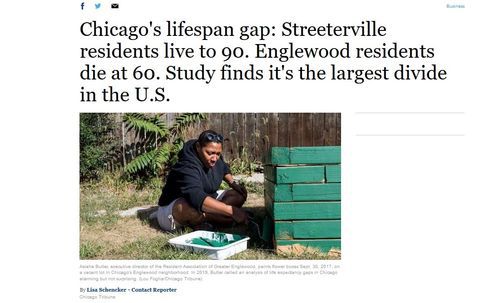
Despite Roving MAGA Lynch Mobs, Chicago’s Streeterville Neighborhood in Chicago Has Average Life Expectancy of 90
By Steve Sailer
06/08/2019
 |
|
Streeterville |
From the Chicago Tribune:
Lisa Schencker Contact Reporter
In the gleaming Streeterville neighborhood, Chicagoans live to be 90 years old, on average.
But just about 9 miles south, in Englewood, the average life expectancy plummets to about 60 years, according to a new NYU School of Medicine analysis.
The 30-year gap between the neighborhoods is the largest in the country, according to the NYU researchers, who examined life expectancies in neighborhoods in the 500 biggest U.S. cities based on data from the Centers for Disease Control and Prevention from 2010 to 2015.
Neighborhoods with higher life expectancies tend to have access to good health care, high educational attainment and higher income, among other things,
Such as roving MAGA lynch mobs out looking to murder gay black TV stars during polar vortexes.
said Dr. Marc Gourevitch, chair of the Department of Population Health at New York University medical school and chief architect of the City Health Dashboard, a public database through which researchers did their analysis.
“There’s a saying that your ZIP code has as much to do with health as your genetic code, and I think it’s data like this that really shine a light on a statement like that and bring it to life,” Gourevitch said.
The researchers also found that cities with bigger life expectancy gaps tended to have greater racial segregation. Chicago was more segregated than most of the other cities they analyzed.
 |
|
Englewood |
Have you noticed how “segregation” has become a statistical euphemism for “black”?
Apparently, a lot of people are fooled by this rather clumsy sleight-of-hand.
“Often where there are greater concentrations in large cities of Latino or African American populations there can be neighborhoods, at times, where (there has been) more disinvestment in basic social services like education, housing, clean water, safe streets,” Gourevitch said.
Also, due to disinvestment in segregated neighborhoods, there are more people shooting each other. Or maybe … the shooting causes the disinvestment?
No! That’s unthinkable. Stop thinking that!
In Englewood, neighborhood parks aren’t family friendly, fresh vegetables aren’t as readily available and gyms are few and far between, she said. Meanwhile liquor, cigarettes and drugs are readily available.
Also, in Englewood, residents shoot each other a lot.
As Yogi Berra might have said, Englewood got so unpopular that nobody lives there anymore:
| Historical population | |||
|---|---|---|---|
| Census | Pop. | %± | |
| 1930 | 89,063 | — | |
| 1940 | 92,849 | 4.3% | |
| 1950 | 94,134 | 1.4% | |
| 1960 | 97,595 | 3.7% | |
| 1970 | 89,659 | −8.1% | |
| 1980 | 59,075 | −34.1% | |
| 1990 | 48,434 | −18.0% | |
| 2000 | 40,222 | −17.0% | |
| 2010 | 30,654 | −23.8% | |
| Est. 2015 | 26,121 | −14.8% | |
To paraphrase Greta Garbo in Ninotchka on the impact of the Soviet Purge Trials, each Census finds fewer but worse Englewoodians.
